Business Principles: Market Analysis, Innovation, Finance Report
VerifiedAdded on 2020/10/04
|11
|3098
|76
Report
AI Summary
This report delves into the fundamental principles of business, encompassing various key areas. It begins by defining business markets, differentiating between consumer, service, industrial, business-to-business, and professional services markets, and exploring the interactions between businesses. The report then examines business innovation, including its models, the product or service development process, and the associated benefits, risks, and implications. Financial viability, consequences of poor financial management, and financial terminology are discussed to understand financial aspects. Furthermore, the report covers budgeting, marketing principles, sales processes, market research, and the value of branding, providing a comprehensive overview of essential business concepts.
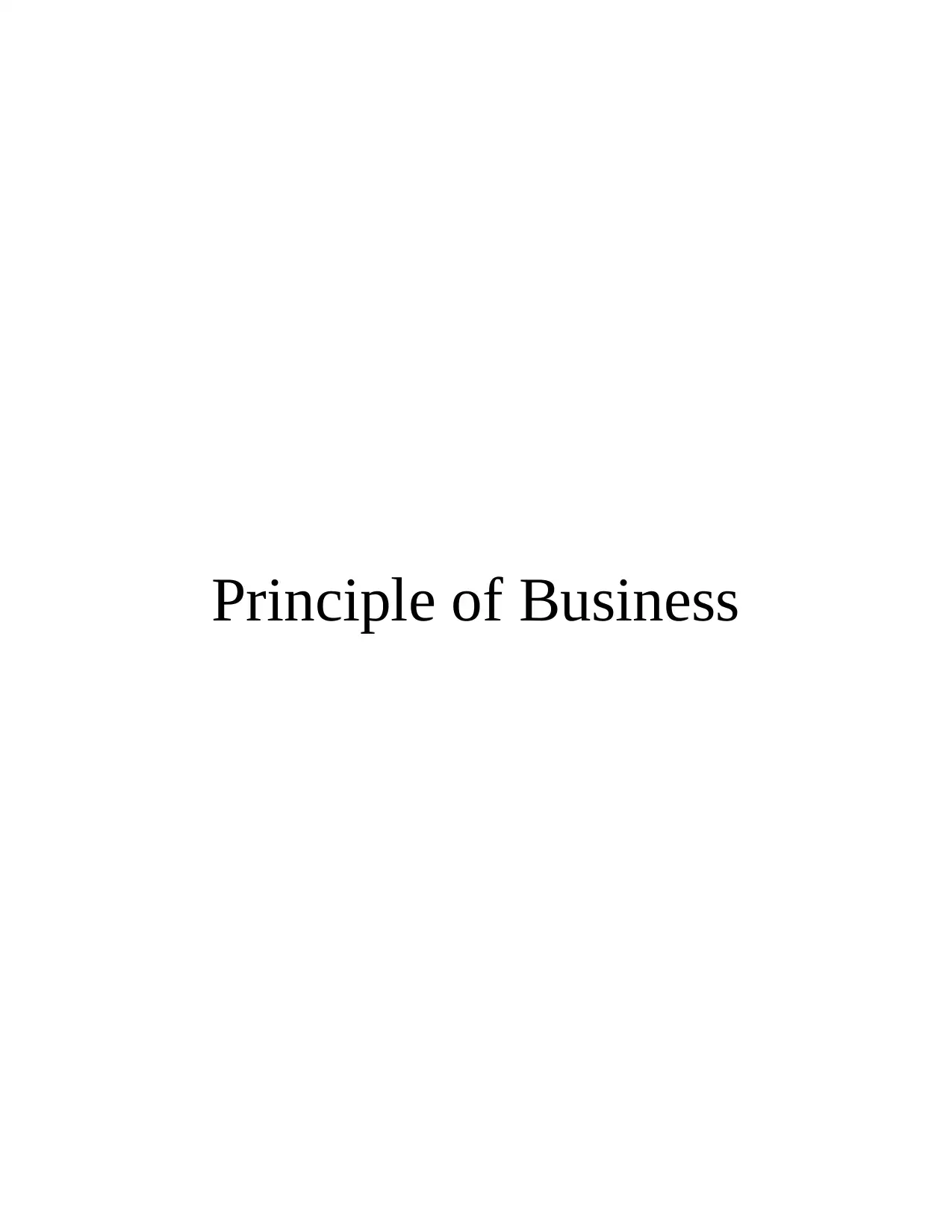
Principle of Business
Paraphrase This Document
Need a fresh take? Get an instant paraphrase of this document with our AI Paraphraser
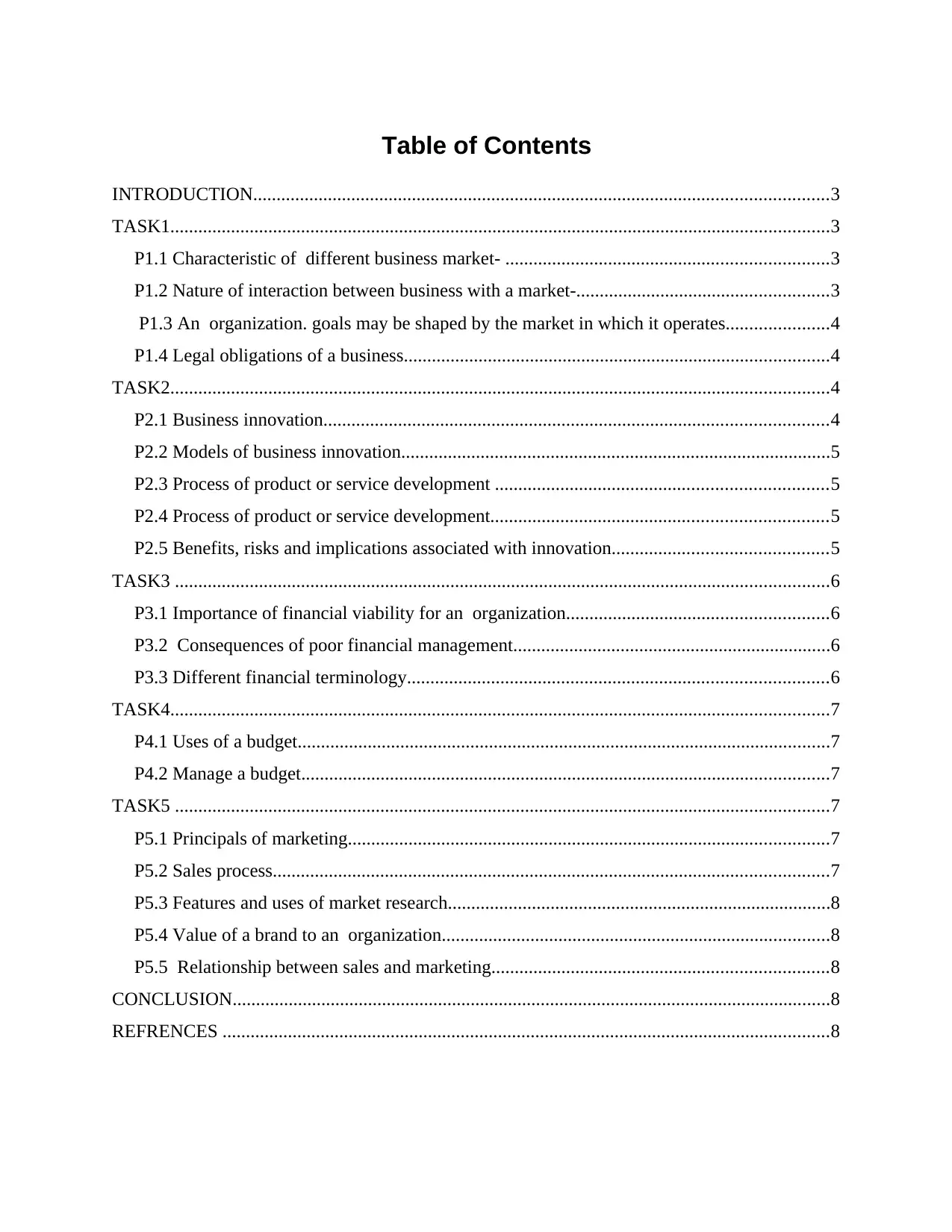
Table of Contents
INTRODUCTION...........................................................................................................................3
TASK1.............................................................................................................................................3
P1.1 Characteristic of different business market- .....................................................................3
P1.2 Nature of interaction between business with a market-......................................................3
P1.3 An organization. goals may be shaped by the market in which it operates......................4
P1.4 Legal obligations of a business...........................................................................................4
TASK2.............................................................................................................................................4
P2.1 Business innovation............................................................................................................4
P2.2 Models of business innovation............................................................................................5
P2.3 Process of product or service development .......................................................................5
P2.4 Process of product or service development........................................................................5
P2.5 Benefits, risks and implications associated with innovation..............................................5
TASK3 ............................................................................................................................................6
P3.1 Importance of financial viability for an organization........................................................6
P3.2 Consequences of poor financial management....................................................................6
P3.3 Different financial terminology..........................................................................................6
TASK4.............................................................................................................................................7
P4.1 Uses of a budget..................................................................................................................7
P4.2 Manage a budget.................................................................................................................7
TASK5 ............................................................................................................................................7
P5.1 Principals of marketing.......................................................................................................7
P5.2 Sales process.......................................................................................................................7
P5.3 Features and uses of market research..................................................................................8
P5.4 Value of a brand to an organization...................................................................................8
P5.5 Relationship between sales and marketing........................................................................8
CONCLUSION................................................................................................................................8
REFRENCES ..................................................................................................................................8
INTRODUCTION...........................................................................................................................3
TASK1.............................................................................................................................................3
P1.1 Characteristic of different business market- .....................................................................3
P1.2 Nature of interaction between business with a market-......................................................3
P1.3 An organization. goals may be shaped by the market in which it operates......................4
P1.4 Legal obligations of a business...........................................................................................4
TASK2.............................................................................................................................................4
P2.1 Business innovation............................................................................................................4
P2.2 Models of business innovation............................................................................................5
P2.3 Process of product or service development .......................................................................5
P2.4 Process of product or service development........................................................................5
P2.5 Benefits, risks and implications associated with innovation..............................................5
TASK3 ............................................................................................................................................6
P3.1 Importance of financial viability for an organization........................................................6
P3.2 Consequences of poor financial management....................................................................6
P3.3 Different financial terminology..........................................................................................6
TASK4.............................................................................................................................................7
P4.1 Uses of a budget..................................................................................................................7
P4.2 Manage a budget.................................................................................................................7
TASK5 ............................................................................................................................................7
P5.1 Principals of marketing.......................................................................................................7
P5.2 Sales process.......................................................................................................................7
P5.3 Features and uses of market research..................................................................................8
P5.4 Value of a brand to an organization...................................................................................8
P5.5 Relationship between sales and marketing........................................................................8
CONCLUSION................................................................................................................................8
REFRENCES ..................................................................................................................................8
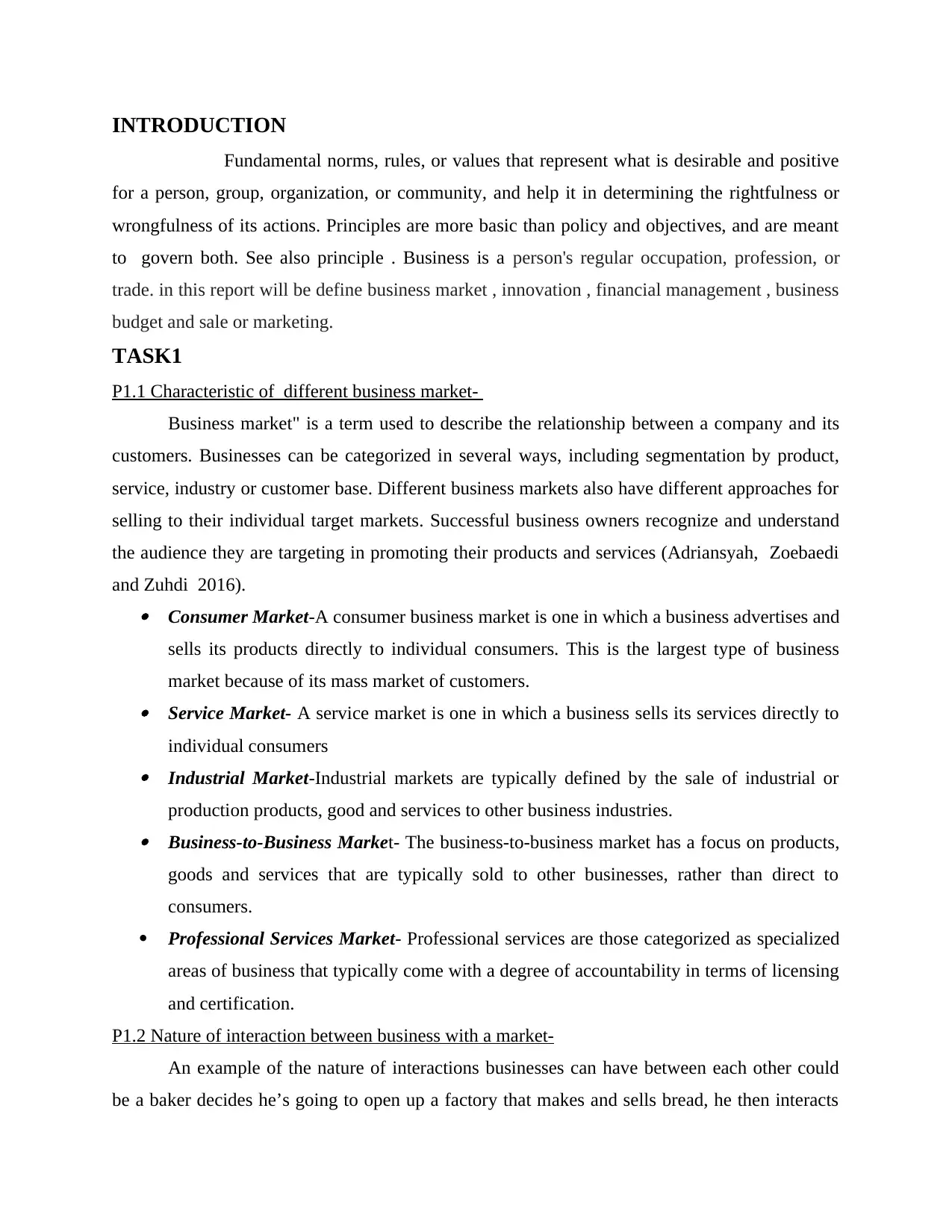
INTRODUCTION
Fundamental norms, rules, or values that represent what is desirable and positive
for a person, group, organization, or community, and help it in determining the rightfulness or
wrongfulness of its actions. Principles are more basic than policy and objectives, and are meant
to govern both. See also principle . Business is a person's regular occupation, profession, or
trade. in this report will be define business market , innovation , financial management , business
budget and sale or marketing.
TASK1
P1.1 Characteristic of different business market-
Business market" is a term used to describe the relationship between a company and its
customers. Businesses can be categorized in several ways, including segmentation by product,
service, industry or customer base. Different business markets also have different approaches for
selling to their individual target markets. Successful business owners recognize and understand
the audience they are targeting in promoting their products and services (Adriansyah, Zoebaedi
and Zuhdi 2016). Consumer Market-A consumer business market is one in which a business advertises and
sells its products directly to individual consumers. This is the largest type of business
market because of its mass market of customers. Service Market- A service market is one in which a business sells its services directly to
individual consumers Industrial Market-Industrial markets are typically defined by the sale of industrial or
production products, good and services to other business industries. Business-to-Business Market- The business-to-business market has a focus on products,
goods and services that are typically sold to other businesses, rather than direct to
consumers.
Professional Services Market- Professional services are those categorized as specialized
areas of business that typically come with a degree of accountability in terms of licensing
and certification.
P1.2 Nature of interaction between business with a market-
An example of the nature of interactions businesses can have between each other could
be a baker decides he’s going to open up a factory that makes and sells bread, he then interacts
Fundamental norms, rules, or values that represent what is desirable and positive
for a person, group, organization, or community, and help it in determining the rightfulness or
wrongfulness of its actions. Principles are more basic than policy and objectives, and are meant
to govern both. See also principle . Business is a person's regular occupation, profession, or
trade. in this report will be define business market , innovation , financial management , business
budget and sale or marketing.
TASK1
P1.1 Characteristic of different business market-
Business market" is a term used to describe the relationship between a company and its
customers. Businesses can be categorized in several ways, including segmentation by product,
service, industry or customer base. Different business markets also have different approaches for
selling to their individual target markets. Successful business owners recognize and understand
the audience they are targeting in promoting their products and services (Adriansyah, Zoebaedi
and Zuhdi 2016). Consumer Market-A consumer business market is one in which a business advertises and
sells its products directly to individual consumers. This is the largest type of business
market because of its mass market of customers. Service Market- A service market is one in which a business sells its services directly to
individual consumers Industrial Market-Industrial markets are typically defined by the sale of industrial or
production products, good and services to other business industries. Business-to-Business Market- The business-to-business market has a focus on products,
goods and services that are typically sold to other businesses, rather than direct to
consumers.
Professional Services Market- Professional services are those categorized as specialized
areas of business that typically come with a degree of accountability in terms of licensing
and certification.
P1.2 Nature of interaction between business with a market-
An example of the nature of interactions businesses can have between each other could
be a baker decides he’s going to open up a factory that makes and sells bread, he then interacts
⊘ This is a preview!⊘
Do you want full access?
Subscribe today to unlock all pages.

Trusted by 1+ million students worldwide
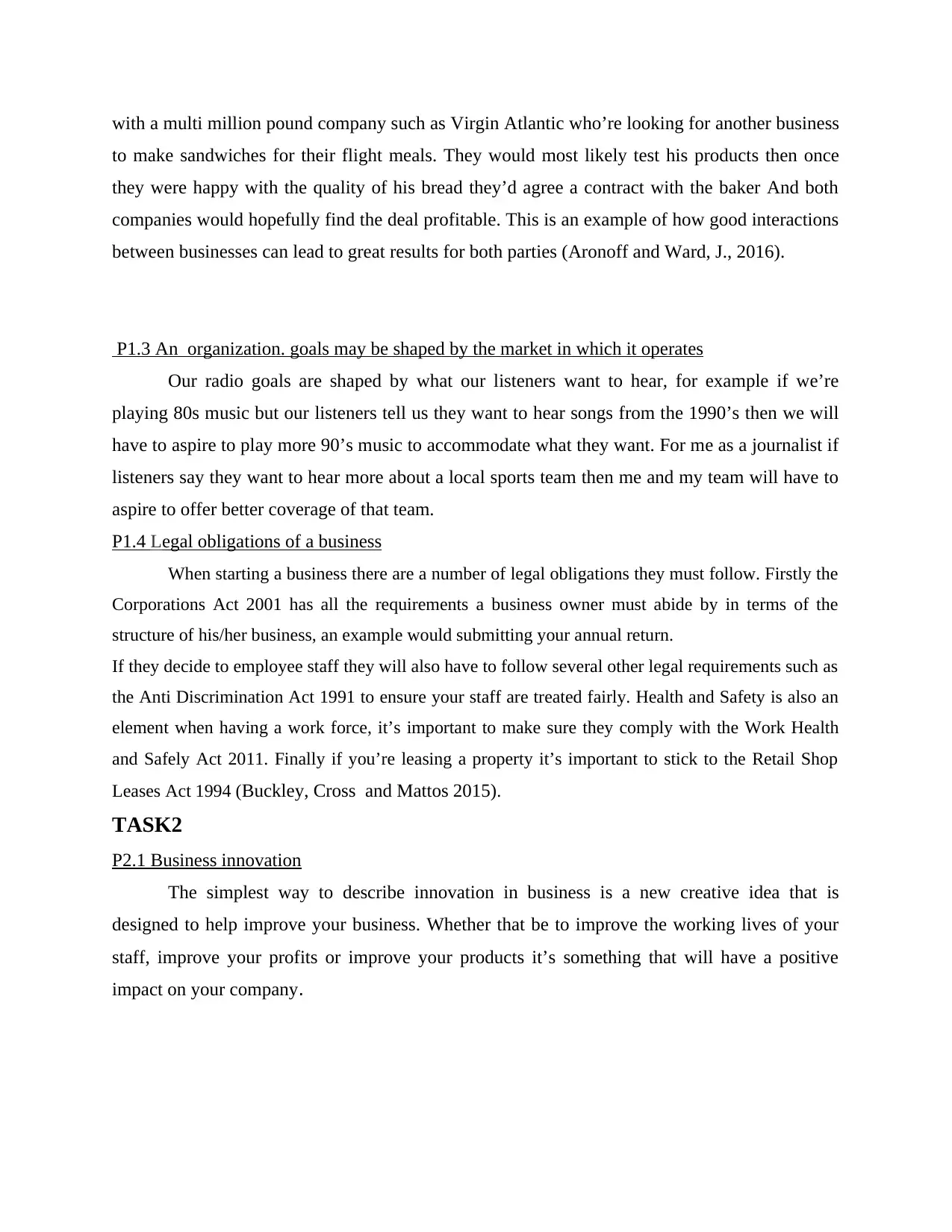
with a multi million pound company such as Virgin Atlantic who’re looking for another business
to make sandwiches for their flight meals. They would most likely test his products then once
they were happy with the quality of his bread they’d agree a contract with the baker And both
companies would hopefully find the deal profitable. This is an example of how good interactions
between businesses can lead to great results for both parties (Aronoff and Ward, J., 2016).
P1.3 An organization. goals may be shaped by the market in which it operates
Our radio goals are shaped by what our listeners want to hear, for example if we’re
playing 80s music but our listeners tell us they want to hear songs from the 1990’s then we will
have to aspire to play more 90’s music to accommodate what they want. For me as a journalist if
listeners say they want to hear more about a local sports team then me and my team will have to
aspire to offer better coverage of that team.
P1.4 Legal obligations of a business
When starting a business there are a number of legal obligations they must follow. Firstly the
Corporations Act 2001 has all the requirements a business owner must abide by in terms of the
structure of his/her business, an example would submitting your annual return.
If they decide to employee staff they will also have to follow several other legal requirements such as
the Anti Discrimination Act 1991 to ensure your staff are treated fairly. Health and Safety is also an
element when having a work force, it’s important to make sure they comply with the Work Health
and Safely Act 2011. Finally if you’re leasing a property it’s important to stick to the Retail Shop
Leases Act 1994 (Buckley, Cross and Mattos 2015).
TASK2
P2.1 Business innovation
The simplest way to describe innovation in business is a new creative idea that is
designed to help improve your business. Whether that be to improve the working lives of your
staff, improve your profits or improve your products it’s something that will have a positive
impact on your company.
to make sandwiches for their flight meals. They would most likely test his products then once
they were happy with the quality of his bread they’d agree a contract with the baker And both
companies would hopefully find the deal profitable. This is an example of how good interactions
between businesses can lead to great results for both parties (Aronoff and Ward, J., 2016).
P1.3 An organization. goals may be shaped by the market in which it operates
Our radio goals are shaped by what our listeners want to hear, for example if we’re
playing 80s music but our listeners tell us they want to hear songs from the 1990’s then we will
have to aspire to play more 90’s music to accommodate what they want. For me as a journalist if
listeners say they want to hear more about a local sports team then me and my team will have to
aspire to offer better coverage of that team.
P1.4 Legal obligations of a business
When starting a business there are a number of legal obligations they must follow. Firstly the
Corporations Act 2001 has all the requirements a business owner must abide by in terms of the
structure of his/her business, an example would submitting your annual return.
If they decide to employee staff they will also have to follow several other legal requirements such as
the Anti Discrimination Act 1991 to ensure your staff are treated fairly. Health and Safety is also an
element when having a work force, it’s important to make sure they comply with the Work Health
and Safely Act 2011. Finally if you’re leasing a property it’s important to stick to the Retail Shop
Leases Act 1994 (Buckley, Cross and Mattos 2015).
TASK2
P2.1 Business innovation
The simplest way to describe innovation in business is a new creative idea that is
designed to help improve your business. Whether that be to improve the working lives of your
staff, improve your profits or improve your products it’s something that will have a positive
impact on your company.
Paraphrase This Document
Need a fresh take? Get an instant paraphrase of this document with our AI Paraphraser
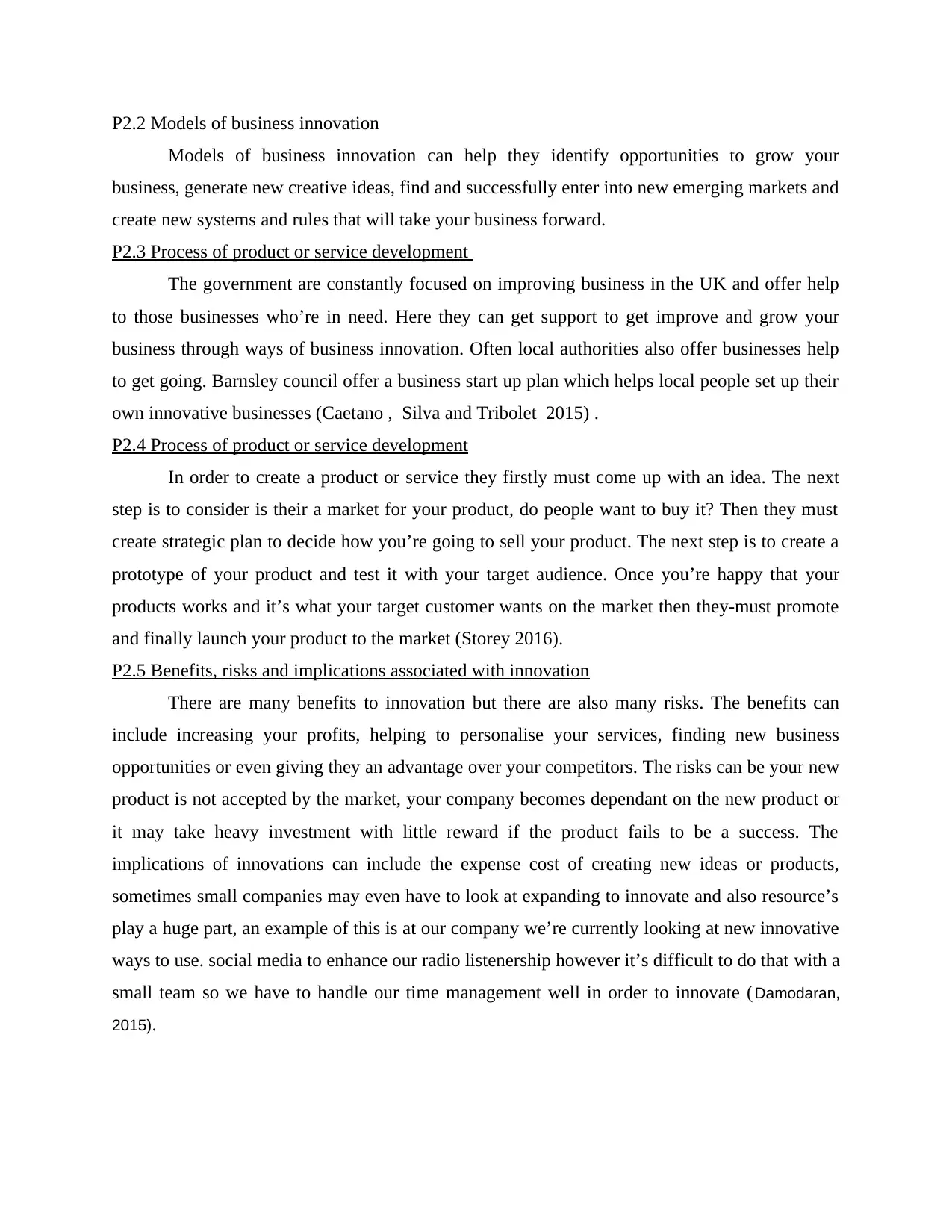
P2.2 Models of business innovation
Models of business innovation can help they identify opportunities to grow your
business, generate new creative ideas, find and successfully enter into new emerging markets and
create new systems and rules that will take your business forward.
P2.3 Process of product or service development
The government are constantly focused on improving business in the UK and offer help
to those businesses who’re in need. Here they can get support to get improve and grow your
business through ways of business innovation. Often local authorities also offer businesses help
to get going. Barnsley council offer a business start up plan which helps local people set up their
own innovative businesses (Caetano , Silva and Tribolet 2015) .
P2.4 Process of product or service development
In order to create a product or service they firstly must come up with an idea. The next
step is to consider is their a market for your product, do people want to buy it? Then they must
create strategic plan to decide how you’re going to sell your product. The next step is to create a
prototype of your product and test it with your target audience. Once you’re happy that your
products works and it’s what your target customer wants on the market then they-must promote
and finally launch your product to the market (Storey 2016).
P2.5 Benefits, risks and implications associated with innovation
There are many benefits to innovation but there are also many risks. The benefits can
include increasing your profits, helping to personalise your services, finding new business
opportunities or even giving they an advantage over your competitors. The risks can be your new
product is not accepted by the market, your company becomes dependant on the new product or
it may take heavy investment with little reward if the product fails to be a success. The
implications of innovations can include the expense cost of creating new ideas or products,
sometimes small companies may even have to look at expanding to innovate and also resource’s
play a huge part, an example of this is at our company we’re currently looking at new innovative
ways to use. social media to enhance our radio listenership however it’s difficult to do that with a
small team so we have to handle our time management well in order to innovate (Damodaran,
2015).
Models of business innovation can help they identify opportunities to grow your
business, generate new creative ideas, find and successfully enter into new emerging markets and
create new systems and rules that will take your business forward.
P2.3 Process of product or service development
The government are constantly focused on improving business in the UK and offer help
to those businesses who’re in need. Here they can get support to get improve and grow your
business through ways of business innovation. Often local authorities also offer businesses help
to get going. Barnsley council offer a business start up plan which helps local people set up their
own innovative businesses (Caetano , Silva and Tribolet 2015) .
P2.4 Process of product or service development
In order to create a product or service they firstly must come up with an idea. The next
step is to consider is their a market for your product, do people want to buy it? Then they must
create strategic plan to decide how you’re going to sell your product. The next step is to create a
prototype of your product and test it with your target audience. Once you’re happy that your
products works and it’s what your target customer wants on the market then they-must promote
and finally launch your product to the market (Storey 2016).
P2.5 Benefits, risks and implications associated with innovation
There are many benefits to innovation but there are also many risks. The benefits can
include increasing your profits, helping to personalise your services, finding new business
opportunities or even giving they an advantage over your competitors. The risks can be your new
product is not accepted by the market, your company becomes dependant on the new product or
it may take heavy investment with little reward if the product fails to be a success. The
implications of innovations can include the expense cost of creating new ideas or products,
sometimes small companies may even have to look at expanding to innovate and also resource’s
play a huge part, an example of this is at our company we’re currently looking at new innovative
ways to use. social media to enhance our radio listenership however it’s difficult to do that with a
small team so we have to handle our time management well in order to innovate (Damodaran,
2015).
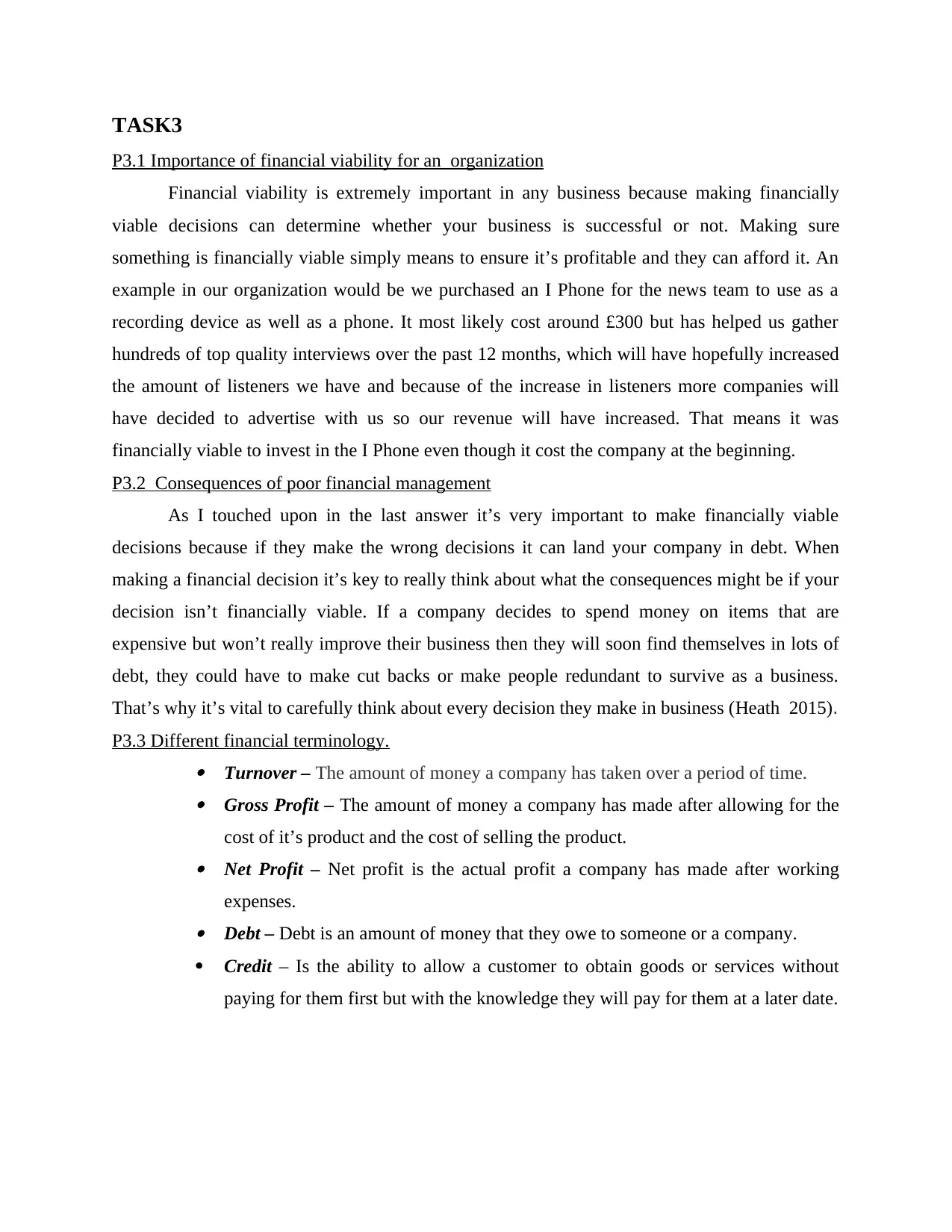
TASK3
P3.1 Importance of financial viability for an organization
Financial viability is extremely important in any business because making financially
viable decisions can determine whether your business is successful or not. Making sure
something is financially viable simply means to ensure it’s profitable and they can afford it. An
example in our organization would be we purchased an I Phone for the news team to use as a
recording device as well as a phone. It most likely cost around £300 but has helped us gather
hundreds of top quality interviews over the past 12 months, which will have hopefully increased
the amount of listeners we have and because of the increase in listeners more companies will
have decided to advertise with us so our revenue will have increased. That means it was
financially viable to invest in the I Phone even though it cost the company at the beginning.
P3.2 Consequences of poor financial management
As I touched upon in the last answer it’s very important to make financially viable
decisions because if they make the wrong decisions it can land your company in debt. When
making a financial decision it’s key to really think about what the consequences might be if your
decision isn’t financially viable. If a company decides to spend money on items that are
expensive but won’t really improve their business then they will soon find themselves in lots of
debt, they could have to make cut backs or make people redundant to survive as a business.
That’s why it’s vital to carefully think about every decision they make in business (Heath 2015).
P3.3 Different financial terminology.
Turnover – The amount of money a company has taken over a period of time.
Gross Profit – The amount of money a company has made after allowing for the
cost of it’s product and the cost of selling the product.
Net Profit – Net profit is the actual profit a company has made after working
expenses.
Debt – Debt is an amount of money that they owe to someone or a company.
Credit – Is the ability to allow a customer to obtain goods or services without
paying for them first but with the knowledge they will pay for them at a later date.
P3.1 Importance of financial viability for an organization
Financial viability is extremely important in any business because making financially
viable decisions can determine whether your business is successful or not. Making sure
something is financially viable simply means to ensure it’s profitable and they can afford it. An
example in our organization would be we purchased an I Phone for the news team to use as a
recording device as well as a phone. It most likely cost around £300 but has helped us gather
hundreds of top quality interviews over the past 12 months, which will have hopefully increased
the amount of listeners we have and because of the increase in listeners more companies will
have decided to advertise with us so our revenue will have increased. That means it was
financially viable to invest in the I Phone even though it cost the company at the beginning.
P3.2 Consequences of poor financial management
As I touched upon in the last answer it’s very important to make financially viable
decisions because if they make the wrong decisions it can land your company in debt. When
making a financial decision it’s key to really think about what the consequences might be if your
decision isn’t financially viable. If a company decides to spend money on items that are
expensive but won’t really improve their business then they will soon find themselves in lots of
debt, they could have to make cut backs or make people redundant to survive as a business.
That’s why it’s vital to carefully think about every decision they make in business (Heath 2015).
P3.3 Different financial terminology.
Turnover – The amount of money a company has taken over a period of time.
Gross Profit – The amount of money a company has made after allowing for the
cost of it’s product and the cost of selling the product.
Net Profit – Net profit is the actual profit a company has made after working
expenses.
Debt – Debt is an amount of money that they owe to someone or a company.
Credit – Is the ability to allow a customer to obtain goods or services without
paying for them first but with the knowledge they will pay for them at a later date.
⊘ This is a preview!⊘
Do you want full access?
Subscribe today to unlock all pages.

Trusted by 1+ million students worldwide
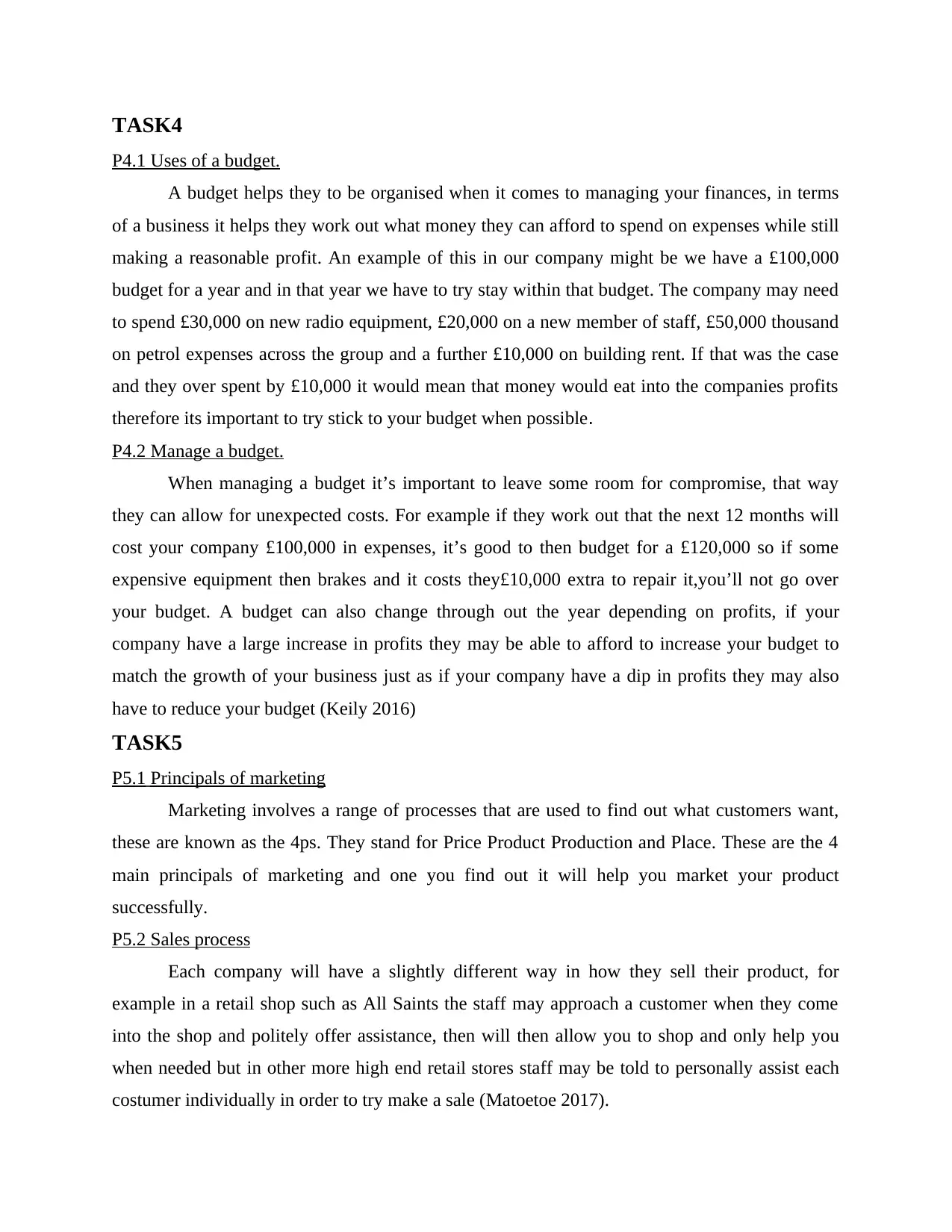
TASK4
P4.1 Uses of a budget.
A budget helps they to be organised when it comes to managing your finances, in terms
of a business it helps they work out what money they can afford to spend on expenses while still
making a reasonable profit. An example of this in our company might be we have a £100,000
budget for a year and in that year we have to try stay within that budget. The company may need
to spend £30,000 on new radio equipment, £20,000 on a new member of staff, £50,000 thousand
on petrol expenses across the group and a further £10,000 on building rent. If that was the case
and they over spent by £10,000 it would mean that money would eat into the companies profits
therefore its important to try stick to your budget when possible.
P4.2 Manage a budget.
When managing a budget it’s important to leave some room for compromise, that way
they can allow for unexpected costs. For example if they work out that the next 12 months will
cost your company £100,000 in expenses, it’s good to then budget for a £120,000 so if some
expensive equipment then brakes and it costs they£10,000 extra to repair it,you’ll not go over
your budget. A budget can also change through out the year depending on profits, if your
company have a large increase in profits they may be able to afford to increase your budget to
match the growth of your business just as if your company have a dip in profits they may also
have to reduce your budget (Keily 2016)
TASK5
P5.1 Principals of marketing
Marketing involves a range of processes that are used to find out what customers want,
these are known as the 4ps. They stand for Price Product Production and Place. These are the 4
main principals of marketing and one you find out it will help you market your product
successfully.
P5.2 Sales process
Each company will have a slightly different way in how they sell their product, for
example in a retail shop such as All Saints the staff may approach a customer when they come
into the shop and politely offer assistance, then will then allow you to shop and only help you
when needed but in other more high end retail stores staff may be told to personally assist each
costumer individually in order to try make a sale (Matoetoe 2017).
P4.1 Uses of a budget.
A budget helps they to be organised when it comes to managing your finances, in terms
of a business it helps they work out what money they can afford to spend on expenses while still
making a reasonable profit. An example of this in our company might be we have a £100,000
budget for a year and in that year we have to try stay within that budget. The company may need
to spend £30,000 on new radio equipment, £20,000 on a new member of staff, £50,000 thousand
on petrol expenses across the group and a further £10,000 on building rent. If that was the case
and they over spent by £10,000 it would mean that money would eat into the companies profits
therefore its important to try stick to your budget when possible.
P4.2 Manage a budget.
When managing a budget it’s important to leave some room for compromise, that way
they can allow for unexpected costs. For example if they work out that the next 12 months will
cost your company £100,000 in expenses, it’s good to then budget for a £120,000 so if some
expensive equipment then brakes and it costs they£10,000 extra to repair it,you’ll not go over
your budget. A budget can also change through out the year depending on profits, if your
company have a large increase in profits they may be able to afford to increase your budget to
match the growth of your business just as if your company have a dip in profits they may also
have to reduce your budget (Keily 2016)
TASK5
P5.1 Principals of marketing
Marketing involves a range of processes that are used to find out what customers want,
these are known as the 4ps. They stand for Price Product Production and Place. These are the 4
main principals of marketing and one you find out it will help you market your product
successfully.
P5.2 Sales process
Each company will have a slightly different way in how they sell their product, for
example in a retail shop such as All Saints the staff may approach a customer when they come
into the shop and politely offer assistance, then will then allow you to shop and only help you
when needed but in other more high end retail stores staff may be told to personally assist each
costumer individually in order to try make a sale (Matoetoe 2017).
Paraphrase This Document
Need a fresh take? Get an instant paraphrase of this document with our AI Paraphraser
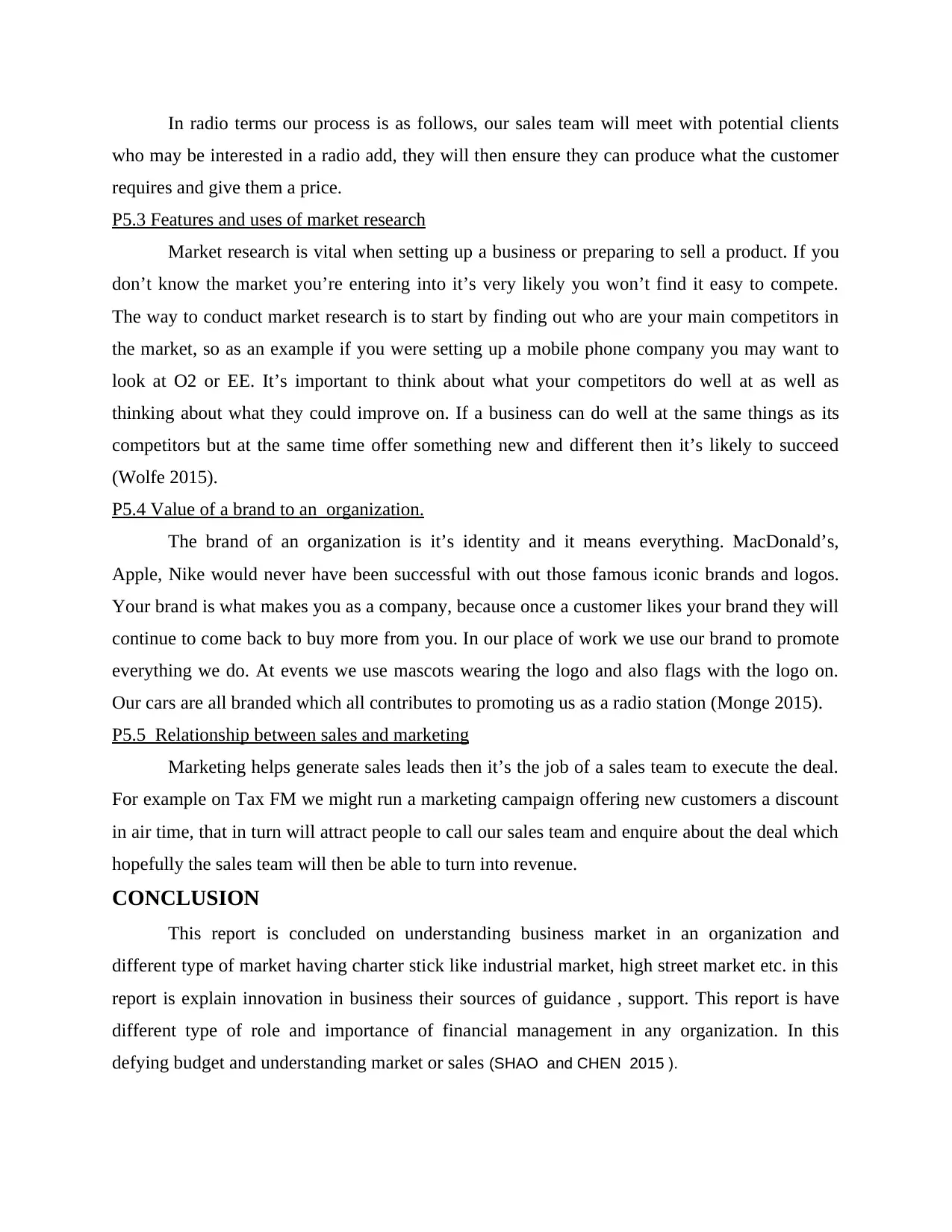
In radio terms our process is as follows, our sales team will meet with potential clients
who may be interested in a radio add, they will then ensure they can produce what the customer
requires and give them a price.
P5.3 Features and uses of market research
Market research is vital when setting up a business or preparing to sell a product. If you
don’t know the market you’re entering into it’s very likely you won’t find it easy to compete.
The way to conduct market research is to start by finding out who are your main competitors in
the market, so as an example if you were setting up a mobile phone company you may want to
look at O2 or EE. It’s important to think about what your competitors do well at as well as
thinking about what they could improve on. If a business can do well at the same things as its
competitors but at the same time offer something new and different then it’s likely to succeed
(Wolfe 2015).
P5.4 Value of a brand to an organization.
The brand of an organization is it’s identity and it means everything. MacDonald’s,
Apple, Nike would never have been successful with out those famous iconic brands and logos.
Your brand is what makes you as a company, because once a customer likes your brand they will
continue to come back to buy more from you. In our place of work we use our brand to promote
everything we do. At events we use mascots wearing the logo and also flags with the logo on.
Our cars are all branded which all contributes to promoting us as a radio station (Monge 2015).
P5.5 Relationship between sales and marketing
Marketing helps generate sales leads then it’s the job of a sales team to execute the deal.
For example on Tax FM we might run a marketing campaign offering new customers a discount
in air time, that in turn will attract people to call our sales team and enquire about the deal which
hopefully the sales team will then be able to turn into revenue.
CONCLUSION
This report is concluded on understanding business market in an organization and
different type of market having charter stick like industrial market, high street market etc. in this
report is explain innovation in business their sources of guidance , support. This report is have
different type of role and importance of financial management in any organization. In this
defying budget and understanding market or sales (SHAO and CHEN 2015 ).
who may be interested in a radio add, they will then ensure they can produce what the customer
requires and give them a price.
P5.3 Features and uses of market research
Market research is vital when setting up a business or preparing to sell a product. If you
don’t know the market you’re entering into it’s very likely you won’t find it easy to compete.
The way to conduct market research is to start by finding out who are your main competitors in
the market, so as an example if you were setting up a mobile phone company you may want to
look at O2 or EE. It’s important to think about what your competitors do well at as well as
thinking about what they could improve on. If a business can do well at the same things as its
competitors but at the same time offer something new and different then it’s likely to succeed
(Wolfe 2015).
P5.4 Value of a brand to an organization.
The brand of an organization is it’s identity and it means everything. MacDonald’s,
Apple, Nike would never have been successful with out those famous iconic brands and logos.
Your brand is what makes you as a company, because once a customer likes your brand they will
continue to come back to buy more from you. In our place of work we use our brand to promote
everything we do. At events we use mascots wearing the logo and also flags with the logo on.
Our cars are all branded which all contributes to promoting us as a radio station (Monge 2015).
P5.5 Relationship between sales and marketing
Marketing helps generate sales leads then it’s the job of a sales team to execute the deal.
For example on Tax FM we might run a marketing campaign offering new customers a discount
in air time, that in turn will attract people to call our sales team and enquire about the deal which
hopefully the sales team will then be able to turn into revenue.
CONCLUSION
This report is concluded on understanding business market in an organization and
different type of market having charter stick like industrial market, high street market etc. in this
report is explain innovation in business their sources of guidance , support. This report is have
different type of role and importance of financial management in any organization. In this
defying budget and understanding market or sales (SHAO and CHEN 2015 ).
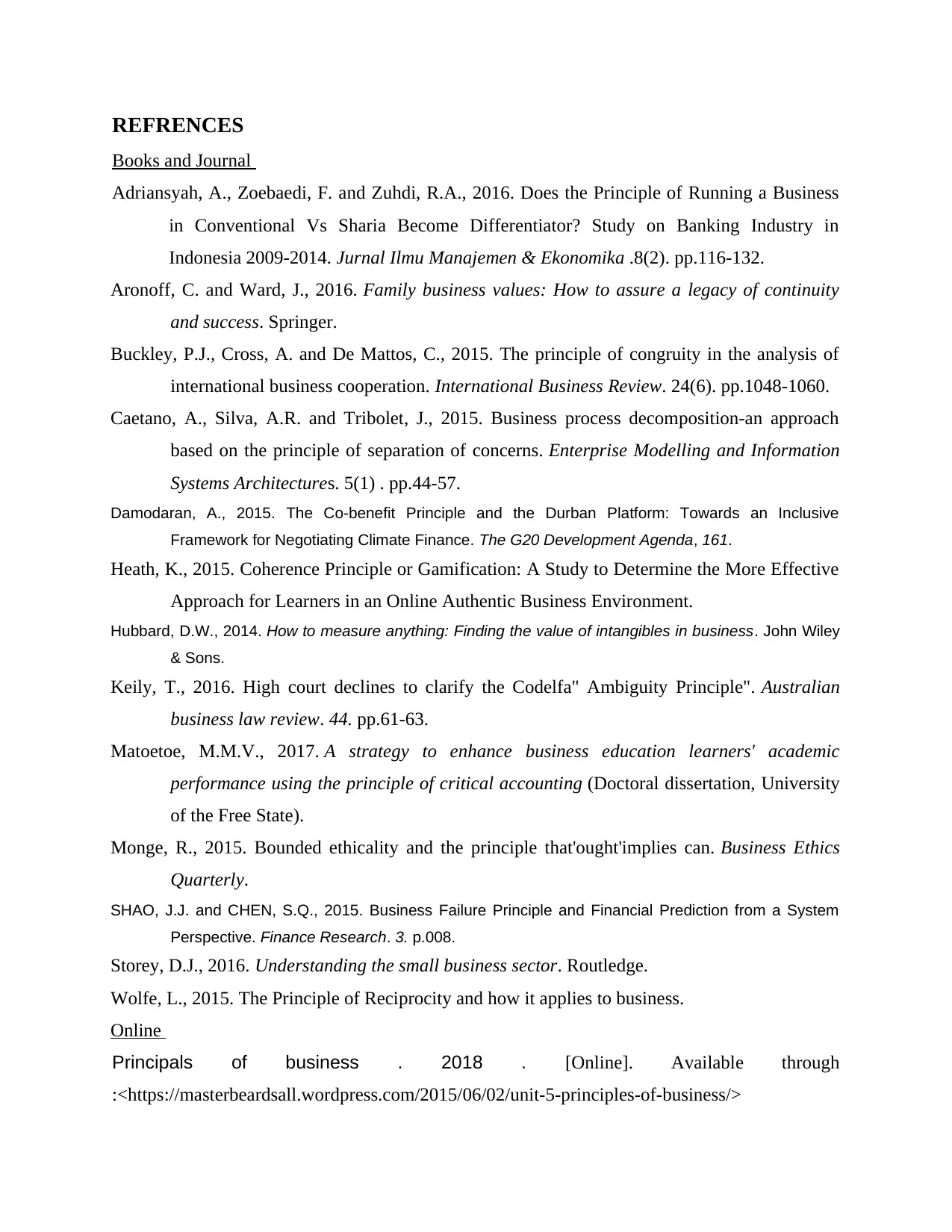
REFRENCES
Books and Journal
Adriansyah, A., Zoebaedi, F. and Zuhdi, R.A., 2016. Does the Principle of Running a Business
in Conventional Vs Sharia Become Differentiator? Study on Banking Industry in
Indonesia 2009-2014. Jurnal Ilmu Manajemen & Ekonomika .8(2). pp.116-132.
Aronoff, C. and Ward, J., 2016. Family business values: How to assure a legacy of continuity
and success. Springer.
Buckley, P.J., Cross, A. and De Mattos, C., 2015. The principle of congruity in the analysis of
international business cooperation. International Business Review. 24(6). pp.1048-1060.
Caetano, A., Silva, A.R. and Tribolet, J., 2015. Business process decomposition-an approach
based on the principle of separation of concerns. Enterprise Modelling and Information
Systems Architectures. 5(1) . pp.44-57.
Damodaran, A., 2015. The Co-benefit Principle and the Durban Platform: Towards an Inclusive
Framework for Negotiating Climate Finance. The G20 Development Agenda, 161.
Heath, K., 2015. Coherence Principle or Gamification: A Study to Determine the More Effective
Approach for Learners in an Online Authentic Business Environment.
Hubbard, D.W., 2014. How to measure anything: Finding the value of intangibles in business. John Wiley
& Sons.
Keily, T., 2016. High court declines to clarify the Codelfa" Ambiguity Principle". Australian
business law review. 44. pp.61-63.
Matoetoe, M.M.V., 2017. A strategy to enhance business education learners' academic
performance using the principle of critical accounting (Doctoral dissertation, University
of the Free State).
Monge, R., 2015. Bounded ethicality and the principle that'ought'implies can. Business Ethics
Quarterly.
SHAO, J.J. and CHEN, S.Q., 2015. Business Failure Principle and Financial Prediction from a System
Perspective. Finance Research. 3. p.008.
Storey, D.J., 2016. Understanding the small business sector. Routledge.
Wolfe, L., 2015. The Principle of Reciprocity and how it applies to business.
Online
Principals of business . 2018 . [Online]. Available through
:<https://masterbeardsall.wordpress.com/2015/06/02/unit-5-principles-of-business/>
Books and Journal
Adriansyah, A., Zoebaedi, F. and Zuhdi, R.A., 2016. Does the Principle of Running a Business
in Conventional Vs Sharia Become Differentiator? Study on Banking Industry in
Indonesia 2009-2014. Jurnal Ilmu Manajemen & Ekonomika .8(2). pp.116-132.
Aronoff, C. and Ward, J., 2016. Family business values: How to assure a legacy of continuity
and success. Springer.
Buckley, P.J., Cross, A. and De Mattos, C., 2015. The principle of congruity in the analysis of
international business cooperation. International Business Review. 24(6). pp.1048-1060.
Caetano, A., Silva, A.R. and Tribolet, J., 2015. Business process decomposition-an approach
based on the principle of separation of concerns. Enterprise Modelling and Information
Systems Architectures. 5(1) . pp.44-57.
Damodaran, A., 2015. The Co-benefit Principle and the Durban Platform: Towards an Inclusive
Framework for Negotiating Climate Finance. The G20 Development Agenda, 161.
Heath, K., 2015. Coherence Principle or Gamification: A Study to Determine the More Effective
Approach for Learners in an Online Authentic Business Environment.
Hubbard, D.W., 2014. How to measure anything: Finding the value of intangibles in business. John Wiley
& Sons.
Keily, T., 2016. High court declines to clarify the Codelfa" Ambiguity Principle". Australian
business law review. 44. pp.61-63.
Matoetoe, M.M.V., 2017. A strategy to enhance business education learners' academic
performance using the principle of critical accounting (Doctoral dissertation, University
of the Free State).
Monge, R., 2015. Bounded ethicality and the principle that'ought'implies can. Business Ethics
Quarterly.
SHAO, J.J. and CHEN, S.Q., 2015. Business Failure Principle and Financial Prediction from a System
Perspective. Finance Research. 3. p.008.
Storey, D.J., 2016. Understanding the small business sector. Routledge.
Wolfe, L., 2015. The Principle of Reciprocity and how it applies to business.
Online
Principals of business . 2018 . [Online]. Available through
:<https://masterbeardsall.wordpress.com/2015/06/02/unit-5-principles-of-business/>
⊘ This is a preview!⊘
Do you want full access?
Subscribe today to unlock all pages.

Trusted by 1+ million students worldwide

Paraphrase This Document
Need a fresh take? Get an instant paraphrase of this document with our AI Paraphraser

1 out of 11
Related Documents
Your All-in-One AI-Powered Toolkit for Academic Success.
+13062052269
info@desklib.com
Available 24*7 on WhatsApp / Email
![[object Object]](/_next/static/media/star-bottom.7253800d.svg)
Unlock your academic potential
Copyright © 2020–2025 A2Z Services. All Rights Reserved. Developed and managed by ZUCOL.





